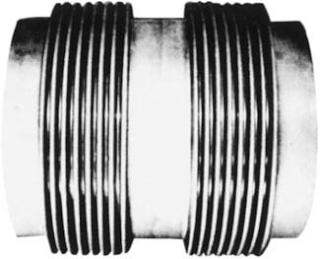Expansion joints are used in piping systems to absorb thermal expansion where the use of expansion loops is undesirable or impractical. Expansion joints are available in slip, ball, metal bellows, and rubber bellows configurations.
Slip-type expansion joints (Fig. 1) have a sleeve that telescopes into the body. Leakage is controlled by packing located between the sleeve and the body. Leakage is minimal and can be near zero in many applications. A completely leak-free seal cannot be ensured; thus these expansion joints are ruled out where zero leakage is required.
 |
| Fig. 1 - Slip-type expansion joint |
The packing is subject to wear due to cyclic movement of the sleeve when connected piping expands and contracts. Thus, these joints require periodic maintenance, either to compress the packing by tightening a packing gland or to replace or replenish the packing. Replacement of the packing rings is necessary when leakage develops in a joint that has an adjustable packing gland which has been tightened to its limit. Some designs provide for packing replenishment rather than replacement. These are usually called gun-packed or ram-packed slip joints. Since the packing can wear away, some packing material may be picked up in the line fluid. This rules out the use of slip joints in systems, where such contamination of fluid cannot be tolerated.
Slip-type expansion joints are particularly suited for lines having straight-line (axial) movements of large magnitude. Slip joints cannot tolerate lateral offset or angular rotation (cocking) since this would cause binding, galling, and possibly leakage due to packing distortion. Therefore, the use of proper pipe alignment
guides is essential.
 |
| Fig. 2 - Typical ball expansion joint |
Ball expansion joints (Fig. 2) consist of a socket and ball with a sealing mechanism placed between them. The seals are of rigid materials, and in some designs a pliable sealant may be injected into the cavity located between the ball and socket. The joints are capable of absorbing angular and axial rotation; however, they cannot accommodate movement along the longitudinal axis of the joint. Therefore, an offset must be installed in the line to absorb pipe axial movement.
 |
| Fig. 3 - Metal bellows expansion joint |
Bellows-type expansion joints (Fig. 3) do not have packing; thus they do not have the potential leakage or fluid contamination problems sometimes associated with slip joints. Likewise, they do not require the periodic maintenance (lubrication and repacking) that is associated with slip joints. Bellows joints absorb expansion and contraction by means of a flexible bellows that is compressed or extended.
They can also accommodate direction changes by various combinations of compression on one side and extension on an opposing side. Thus, they can adjust to lateral offset and angular rotation of the connected piping. However, they are not capable of absorbing torsional movement. Typically, the bellows is corrugated metal and is welded to the end pieces. To provide the requisite flexibility, the metal bellows is considerably thinner than the associated piping. Thus these expansion joints are especially susceptible to rupture by overpressure. A bellows can also fail because of metal fatigue if the accumulated flexing cycles exceed the designed fatigue life (cyclic life) of the bellows or if the flexing extremes exceed the designed compression and extension limits.
 |
| Fig. 4 - Rubber expansion joint |
Rubber expansion joints (Fig. 4) are similar in design to metal bellows expansion joints except that they are constructed of fabric and wire-reinforced elastomer's They are most suitable for use in cold water service where large movements must be absorbed (e.g., condenser circulating water).
Tagged as :
Piping
Piping Design


Hey guys,
ReplyDeleteWanted to share some stuff with you. I used Vistaprint for
some embroidered t-shirts with logo. Damn impressed. Check it out if you can.
These articles are important for any piping engineer...
ReplyDeleteGreat information about expansion joints! These blogs really helps for people working
ReplyDeletein industrial plant. http://www.avbellows.com/fabricexpansion.php